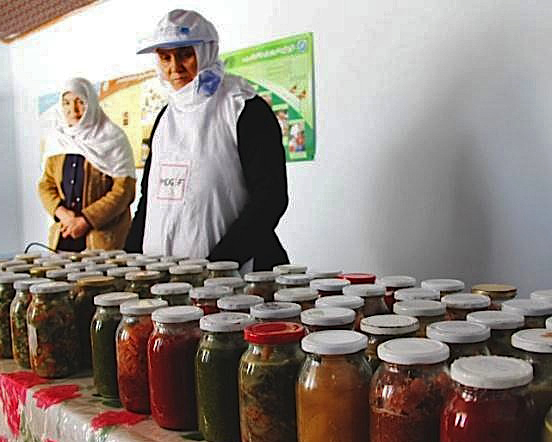

Canning food for better nutrition in Afghanistan

Child and maternal mortality rates in Afghanistan are among the world’s highest. 25% of children die before reaching their fifth birthday. More than half of all children are stunted. 50 women die each day from pregnancy-related complications.
Behind these alarming figures is widespread malnutrition, caused by chronic food insecurity, inadequate access to quality health services and improper feeding and caring practices.
Zia Gul, a mother of five, lives in Dehpora village, in northeastern Afghanistan, one of the most destitute areas on the planet. Poverty here is entrenched, as solid as the mountains that ring this remote province.
“We do not have a good life,” says Zia, whose husband farms to support the 11 people in their household. “It is just making a living for a day. I always thought about whether is it possible to come out of poverty or not? I asked others too and never found a satisfactory answer.”
Empowering women through food production
But last year, Zia learned about a training course in agriculture and food processing that was being offered to village women through an MDG-F programme to reduce malnutrition in Afghanistan.
“Their aim was to empower women and raise their basic knowledge of healthcare and good nutrition. In addition they also planned to teach us the how to process vegetable and fruits,” says Zia, who was encouraged by her husband to take part.
Poor nutrition and a lack of food diversity compromise children’s ability to recover from infections and diseases. Malnutrition also impairs a child’s mental and physical development, and prevents parents from earning stable incomes to support their families.
“Malnutrition is widespread [here] due to lack of dietary diversity, poor knowledge of nutrition, and low income,” says Mrs. Sediga, a local Community Development Council representative “Most of the women don’t know about the nutritional needs of their children. We did a survey … and found that the children were malnourished due to lack of knowledge by their mothers.”
Pickling and canning to boost incomes and improve diets
The MDG-F-funded Joint Programme is working to reduce under-nutrition in children under five and pregnant and lactating mothers through a variety of projects in five provinces in central and eastern Afghanistan. These include boosting agricultural production, educating adults and children about nutritious diets, teaching food processing, and promoting homestead food production to increase food security and produce additional income.
Zia’s group was taught to make tomato paste, pickles and jam, and to dry tomatoes and potatoes. Food processing improves household food security by giving families regular access to diverse foods rich in minerals and vitamins. It minimizes post-harvest waste and improves the marketability of produce, which enables women to earn income by selling food products.
“After being trained in this area, I produced 27 jars of tomato paste, 18 jars of jam and 43 jars of pickle,” says Zia. “From all these, I sold four jars of tomato paste. I also bartered five jars of sauce and two jars of tomato paste for wood. We consumed others in the family and I am continuing to process food so that I can help in the economy of my family.”
The MDG-Fund has established Processing Training and Information Centers in all the programme areas, where women receive monthly training from master trainers selected by local bodies such as women’s cooperatives or Community Development Councils.
A key factor has been community ownership of the projects, which have trained 1,200 women in food processing and provided public demonstrations to 2,200 people on the use of solar dryers for preserving fruits and vegetables. The projects have also helped women to set up producer cooperatives and taught them business skills for marketing.
Khairunessa, a mother of seven from Kabul, joined such a cooperative, and says she has used the additional income she earned from selling her processed foods to buy meats and fruits, greatly diversifying her family’s diet. She has also been able to help pay school fees for her children.
“Since I joined the coop, 15 women from my neighborhood have also joined, and we support each other by pooling money for purchasing raw materials and supplies.”
Working together to serve marginalized communities
Some 400,000 children under five, 120,000 children under two and 130,000 pregnant and lactating women have directly benefitted from “Feeding the Children of Afghanistan Together,” a collaboration between five UN agencies (FAO, UNICEF, WHO, WFP, UNIDO) and the Afghan government and local and community bodies. Two million people have indirectly benefitted.
The programme is grounded in the MDG-F's mission to assist countries in reaching the anti-poverty Millennium Development Goals, and to ensure that advances in development occur equitably and reach the most marginalized and excluded populations.
The districts served by the joint programme -- two each from the provinces of Badakhshan, Nangahar, Daikundi, Bamiyan and Kabul -- were selected because populations there are underserved and suffer from high levels of food insecurity.